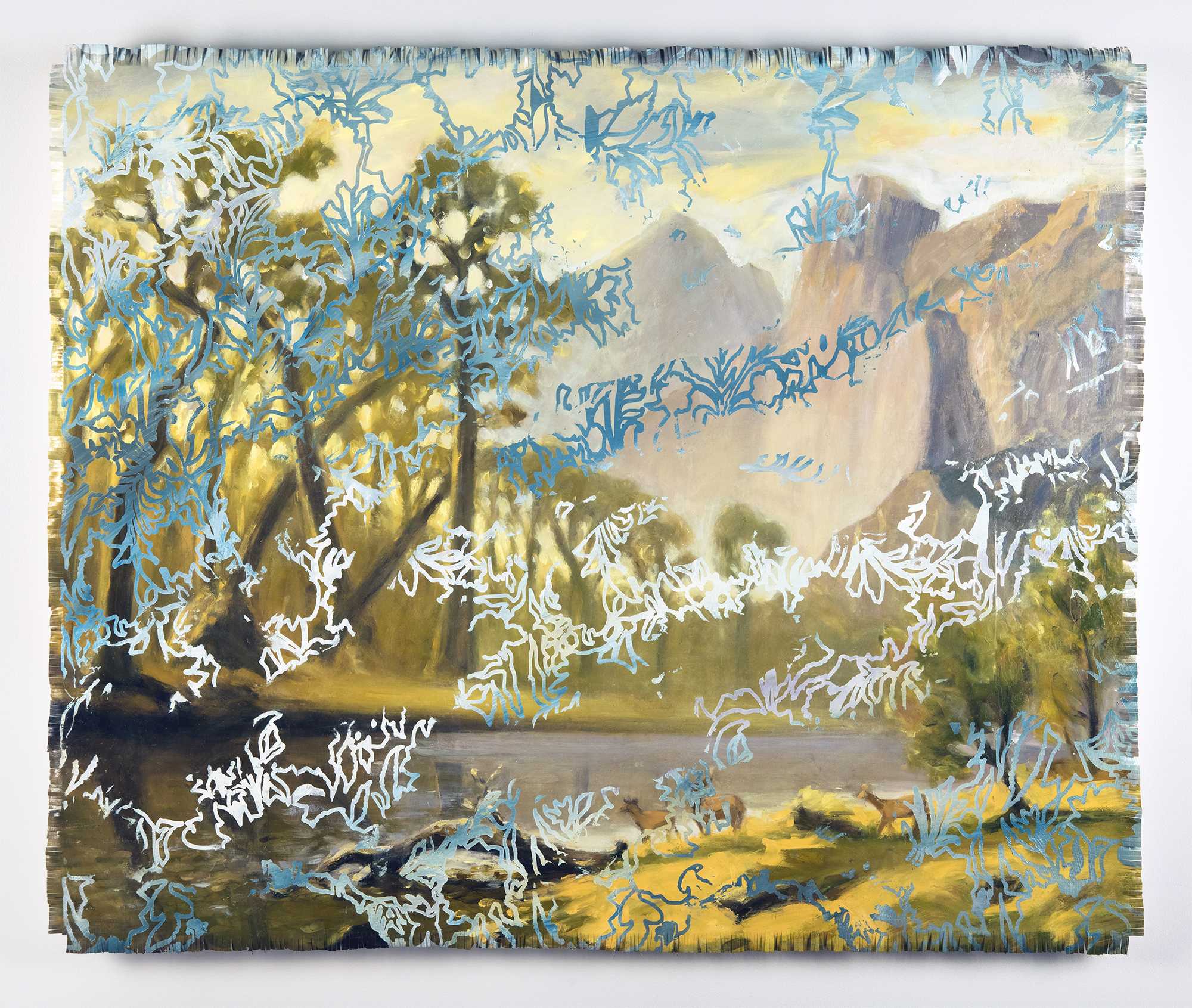
Sally Veach (b. 1962, Summit, NJ) creates contemplative landscape paintings that explore the place of humans within the sublime power of the natural world. Working from her studio at the Torpedo Factory Art Center in Alexandria, VA, she develops layered compositions that invite quiet reflection and moments of connection to the natural environment. At the same time, her process invites viewers to contemplate ecological and societal issues.
Veach’s current series, human Nature, combines atmospheric landscapes with delicate botanical patterns sourced from historic textile collections. Through careful research of museum archives, she develops custom stencils that layer natural motifs throughout her paintings, creating works that feel both timeless and deeply rooted in our shared relationship with nature. Her process builds multiple layers, allowing previous applications to show through like an historical palimpsest, suggesting the accumulation of eras alongside the enduring presence of nature in our lives. Canvas edges often fray into soft fringes, reinforcing the organic, plant based origins of the canvas.
Many pieces draw inspiration from Hudson River School painters, whose sublime landscapes invoked spiritual renewal but also promoted consequential ideas of manifest destiny. Combining symbolic references to the 18th and 19th centuries, Veach’s work celebrates the healing power of landscape at the same time as revealing the complex relationship between humans and nature.
Recognition and Collections
Veach’s work resides in the permanent collections of the Museum of the Shenandoah Valley and the City of Alexandria, Virginia. Her work is held in notable private and corporate collections. In 2022, she was awarded a public art commission for Fairfax County, Virginia. Her paintings were featured in a solo exhibition at the Museum of the Shenandoah Valley andshe is a two-time solo exhibitor at the Delaplaine Arts Center in Frederick, Maryland. Her practice has been supported through three grants from the Marian Park Lewis Foundation.
In 2024, Veach was featured in a two-person exhibition at DC Arts Center and included in two “I Like Your Work Podcast” summer catalogs. Recent group exhibitions include Field Projects in New York, NY, The Athenaeum and Principle Gallery, Alexandria, VA and Washington Studio School, Washington, DC. Forthcoming solo and duo presentations include The Athenaeum in Alexandria, VA, and BlackRock Center for the Arts in Germantown, MD, and Goggleworks in Reading, PA.
Critical recognition includes a Washington Post and HillRag review and multiple local press features. In 2025 she was awarded a multi-disiplinary residency at Oak Springs Garden Foundation in Upperville, VA, where she worked with historic botanical illustrations to create new layered works.
Education and Professional Development
Veach holds a BFA in Illustration from Syracuse University. Her commitment to professional growth includes multiple residencies including Vermont Studio Center, Weir Farm National Historic Park, and Lodestar School of Art in Ireland, as well as continuing education at New York Studio School.
With over ten years of dedicated practice, Veach combines technical expertise with a deep understanding of how art functions therapeutically in institutional and residential settings, creating work that serves both aesthetic and intellectual purposes.
Statement
My art is inspired by thoughts about the sublime power of the natural world and our place within it. In my series, "human Nature," botanical patterns drift across painted landscapes like memories or veils. Canvas edges fray into threads or fringes. Ornamental flora interrupt romantic vistas and arctic seas. My paintings can feel precious yet uneasy, where decoration and wilderness merge and resist each other.
The 18th-century Indian chintz patterns in my work, derived from museum collections, carry a history of desire and exploitation. The global appetite for these botanical designs transformed economies and environments. These exquisite objects represent the intersection of beauty and desire, and our attempts to control the natural world.
With my layering process I create palimpsests where previous paint layers persist and show through masked areas, suggesting successive historical eras and attitudes toward nature that accumulate and persist. The Hudson River School paintings that inform some of these works presented sublime wilderness even as manifest destiny transformed the Western United States. This layering of romantic landscape traditions with decorative botanical forms exposes the tension between idealization and reality.
The title "human Nature" points to our conflicted relationship with the natural world—how we simultaneously revere and reshape it—how we belong to it yet stand apart. These paintings ask whether our decorative impulses reveal devotion or dominance, and whether the patterns we impose on nature ultimately contain it or merely reveal our inability to do so.
